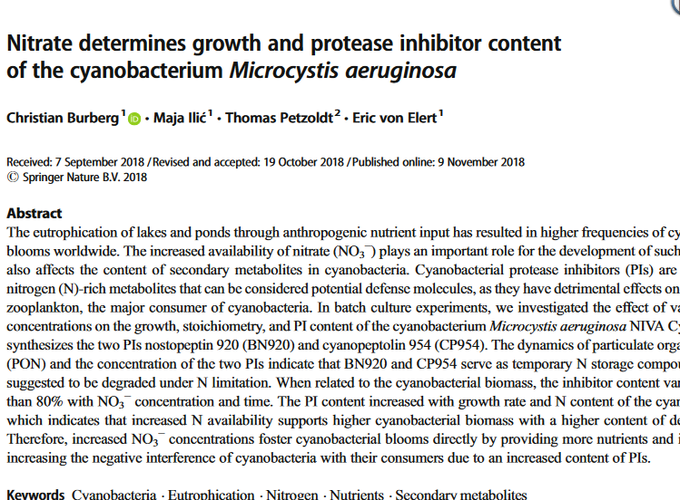Nitrate determines growth and protease inhibitor content of the cyanobacterium Microcystis aeruginosa
Abstract
The eutrophication of lakes and ponds through anthropogenic nutrient input has resulted in higher frequencies of cyanobacterial blooms worldwide. The increased availability of nitrate (NO3−) plays an important role for the development of such blooms and also affects the content of secondary metabolites in cyanobacteria. Cyanobacterial protease inhibitors (PIs) are widespread, nitrogen (N)-rich metabolites that can be considered potential defense molecules, as they have detrimental effects on herbivorous zooplankton, the major consumer of cyanobacteria. In batch culture experiments, we investigated the effect of varying NO3− concentrations on the growth, stoichiometry, and PI content of the cyanobacterium Microcystis aeruginosa NIVA Cya 43, which synthesizes the two PIs nostopeptin 920 (BN920) and cyanopeptolin 954 (CP954). The dynamics of particulate organic nitrogen (PON) and the concentration of the two PIs indicate that BN920 and CP954 serve as temporary N storage compounds and are suggested to be degraded under N limitation. When related to the cyanobacterial biomass, the inhibitor content varied by more than 80% with NO3− concentration and time. The PI content increased with growth rate and N content of the cyanobacterium, which indicates that increased N availability supports higher cyanobacterial biomass with a higher content of defensive PIs. Therefore, increased NO3− concentrations foster cyanobacterial blooms directly by providing more nutrients and indirectly by increasing the negative interference of cyanobacteria with their consumers due to an increased content of PIs.
